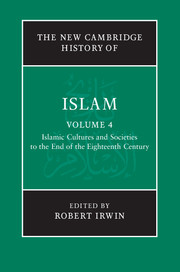Book contents
- Frontmatter
- Introduction
- PART I RELIGION AND LAW
- PART II SOCIETIES, POLITICS AND ECONOMICS
- 7 Legitimacy and political organisation: caliphs, kings and regimes
- 8 The city and the nomad
- 9 Rural life and economy until 1800
- 10 Demography and migration
- 11 The mechanisms of commerce
- 12 Women, gender and sexuality
- PART III LITERATURE
- PART IV LEARNING, ARTS AND CULTURE
- Glossary
- Bibliography
- Index
- References
11 - The mechanisms of commerce
from PART II - SOCIETIES, POLITICS AND ECONOMICS
Published online by Cambridge University Press: 28 March 2011
- Frontmatter
- Introduction
- PART I RELIGION AND LAW
- PART II SOCIETIES, POLITICS AND ECONOMICS
- 7 Legitimacy and political organisation: caliphs, kings and regimes
- 8 The city and the nomad
- 9 Rural life and economy until 1800
- 10 Demography and migration
- 11 The mechanisms of commerce
- 12 Women, gender and sexuality
- PART III LITERATURE
- PART IV LEARNING, ARTS AND CULTURE
- Glossary
- Bibliography
- Index
- References
Summary
Introduction
In the field of English-language scholarship on Islamic history in the 1960s, when the first Cambridge history of Islam was planned and executed, economic history was usually taken to mean the consideration of topics related to agriculture, taxation and trade – both international and local. The editors of the CHI certainly thought economic history was important. In the context of setting the stage for the rest of the work, P. M. Holt wrote the following in the introduction:
In the space of nearly two hundred years that have elapsed since Gibbon wrote, the Renaissance, the Reformation and the Enlightenment have themselves passed into history, and new forces have emerged in the development of European society … At the same time, the methods of historical study have continued to evolve. The source-materials available for research have immensely increased, and the range of techniques at the historian’s disposal has been extended. The aims of the historian have changed in response to both of these factors. Where the pioneers in the field sought primarily to construct, from the best sources they could find, the essential framework of political history, and to chronicle as accurately as possible the acts of rulers, historians today are more conscious of the need to evaluate their materials – a critique all the more important in Islamic history since the control supplied by archives is so largely deficient. They seek to penetrate the dynastic screen, to trace the real sites and shifts of power in the capitals and the camps, and to identify, not merely the leaders or figure-heads, but the ethnic, religious, social or economic groups of anonymous individuals who supported constituted authority or promoted subversion. It is no longer possible, therefore, to segregate the political history of Islam from its social and economic history – although in the latter field especially materials are notably sparse over wide regions and long periods. (emphasis added)
- Type
- Chapter
- Information
- The New Cambridge History of Islam , pp. 332 - 354Publisher: Cambridge University PressPrint publication year: 2010



